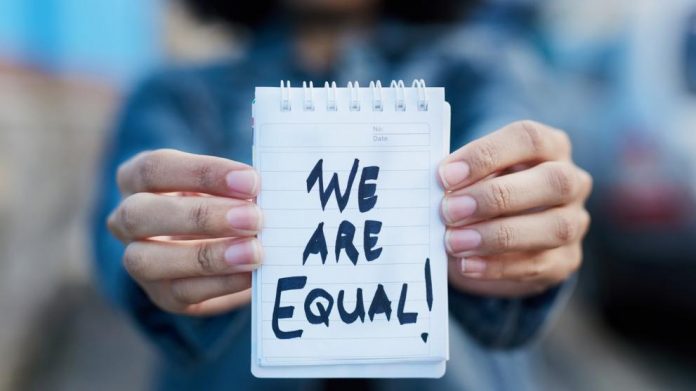This article is written by Ishan Arun Mudbidri from Marathwada Mitra Mandal’s Shankarrao Chavan Law College, Pune. This article talks about the bigger picture of India’s Gender Equality scenario.
Table of Contents
Introduction
Indian women have been treated differently since time immemorial. Even after independence, women were discouraged from doing many things and were deemed as caretakers of the home. This sort of inequality prevailed despite so many goddesses being worshipped in the country. Even today although there is a vast improvement regarding gender equality in comparison to how it was before independence, the mindset of the society towards this is still lacking somewhere.
Gender equality – what the society looks for
Inequality and discrimination lie in the mindset the people hold and the way they approach it. Gender inequality affects everyone, be it children, women, transgenders or even men. Gender equality is a human right but there seems to be a certain gap in access to various opportunities as well as the decision making power for women and men. Women’s empowerment is an important aspect of bringing gender equality. Giving equal opportunities to women and guaranteeing them their equal share of rights, helps in not only achieving gender equality but also in a wide range of development goals.
The existing legal provisions on gender equality in India
The Constitution of India made things a little easier for women in terms of gender equality. The term gender equality in the Constitution is mentioned in its Preamble, Fundamental Rights, Fundamental Duties and Directive Principles of State Policy. The Constitution not only guarantees women’s empowerment but also encourages the State to adopt various measures of equality and empowerment in favour of women.
Constitutional Provisions
Article 14, Article 15, Article 15(3), Article 16, Article 39(a), Article 39(b), Article 39(c) and Article 42 of the Constitution are of specific importance in terms of gender equality and equality in the general sense. Mentioned below are some of the articles:-
Article 14
Article 14 of the Indian Constitution talks about equal status or equality before the law. Every person has equal status before the law and the State cannot deny it.
Article 15
Article 15 prohibits discrimination on the grounds of religion, race, caste, sex and place of birth. This Article cannot prevent the State from making any special provisions for women and children.
Article 16
Article 16 states that there shall be equal opportunity for all citizens of India in matters of employment or appointment to any office.
Article 39
According to Article 39 of the Constitution, the State shall make sure that men and women have an equal right to an adequate livelihood, there is equal pay for men and women, the economic system does not result in the concentration of wealth and the material resources are distributed to serve a common purpose.
Article 42
The State shall secure humane conditions for work and for maternity relief according to Article 42 of the Constitution.
Hence, the Constitution of India makes gender equality a human right. Apart from these constitutional provisions, certain Acts have emerged more or less from these constitutional provisions, which are as follows:
Legal Provisions
The legal provisions are broadly classified into two categories which are:
1. Crimes identified under Special Laws
The Equal Remuneration Act, 1976
Under this Act, the employer must give equal pay or remuneration to men and women for the same work. No employer can, while recruiting, training or transfer, for the same work, or for the work done can discriminate between men and women.
The Criminal Law Amendment Act, 2013
The Criminal Law Amendment Act, 2013 came into force on February 3, 2013 on the recommendation of the Verma Committee Report. This Act added some new offences such as acid attack, sexual harassment, voyeurism, stalking all of which have been incorporated in the Indian Penal Code.
Sexual Harassment of Women at Workplace Act, 2013
The issue was first brought to light in the Vishaka case in 1992, where sexual harassment of women at their place of work was talked about and legislation for the same was passed. Harassing women at their place of work violates the women’s fundamental rights guaranteed under Articles 14, 15 and 21 of the Constitution of India.
The Women’s Reservation Bill
The Women’s Reservation Bill or the Constitution’s 108th Amendment Bill is a pending Bill in which India plans to reserve 33 percent of all seats in the Lower house of Parliament of India, the Lok Sabha, and in all state legislative assemblies for women. The Rajya Sabha or the Upper House of Parliament has not yet voted on this Bill.
The Hindu Succession Act, 1956
Under the Hindu Succession Act, 1956, a certain amendment was made in 2005 leading to the removal of discriminatory provisions. Under the Act, females are granted ownership of all property acquired either before or after the signing of the Act, abolishing their “limited owner” status.
The Maternity Benefit Act, 1961
An amendment was made in 2017 to the Maternity Benefit Act, 1961. Under the Act, paid maternity leave for women employees with less than two surviving children, from the original twelve (12) weeks to twenty-six (26) weeks was extended. The amendment further provided working mothers who have adopted a child below the age of three months, to take 12 weeks of maternity leave from the date of receiving the child and also allowed mothers to work from home after completing 26 weeks subject to their mode of work and employer’s consent.
The Special Marriage Act, 1954
The Special Marriage Act, 1954 provides for a special form of marriage irrespective of religion, or faith that the other party believes in. This Act replaced the Old Act of 1872.
The Dowry Prohibition Act, 1961
This Act prohibits the payment or acceptance of dowry as a consideration for marriage. Asking for or giving of dowry can be punished by imprisonment of up to six months, a fine of up to Rs. 15000 or the amount of dowry, or imprisonment up to 5 years.
2. Crimes Identified under the Indian Penal Code
- Rape (Section 375);
- Kidnapping and abduction (Section 363-373);
- Molestation (Section 354);
- Sexual Harassment (Section 509);
- Importation of a girl (up to 21 years of age);
- Torture (Section 498A);
- Dowry Deaths (Section 304B).
Case Laws
1. Vishaka v. State of Rajasthan (1997)
In this case, the court laid down ‘The Vishaka Guidelines’ which were later converted into the Sexual Harassment of Women at Workplace(Prevention, Prohibition and Redressal) Act, 2013. This case pertains to a woman Bhanwari Devi who was gang-raped by five men as revenge on her for attempting to terminate the marriage of an infant and to fight against the male ego in Rajasthan which was part of her job. The court held that sexual harassment was a clear violation of rights under Articles 14, 15, 19 and 21 of the Indian Constitution.
2. Air India v. Nargesh Meerza (1981)
In this case, an inclusive reading of Article 14 was done by the Supreme Court and it was decided that employment cannot be denied to any person on the grounds of sex. For inflight services, stress was laid on the height of the youth, appearance, and glamour quotient of the employees.
An aviation company called Air India regulated that the air hostesses should retire if they reach the age of 35, conceiving a child, or on marriage whichever occurs earlier. These conditions were derogatory and offending and hence challenged in the court and were later struck down.
3. Laxmi v. Union of India (2015)
Amidst increasing acid attacks, the Supreme Court was called out to issue directives and suggest ways to prevent such attacks. The court instructed the Governments at both levels to prohibit the unauthorised sale of acids across the nation. This decision paved the way to enforce harsher punishments for people involved in such crimes.
4. Vineeta Sharma v. Rakesh Sharma (2020)
In this case, the Supreme Court held that daughters will have equal coparcenary rights in the Hindu Undivided Family by their birth and cannot be excluded from inheritance irrespective of whether they were born before the amendment of 2005 to the Hindu Succession Act, 1956.
Comparison between India and other nations
India has always been a gender-sensitive society and this has been a matter of concern. The current social structure in India states that women are still considered inferior to men. Moreover, India’s rank in the World Economic Forum’s Global Gender Gap Index 2020 is 112th out of the 153 total countries covered. According to the report, India has slipped by 3% in offering equality of opportunity to men and women. Iceland topped in this ranking index with 88% of the gap closed, while India who ranked 112th closed only 66% of the gender gap. The major sectors contributing to this gender gap index are education, health, economy, labour force participation, and politics. India’s ranking, being so low, shows that men are still encouraged more than women.
To compare India with a close ally USA on these dimensions, the US spends much more on education and the health sector than India. Women in the US get better opportunities than Indian women. This shows the negative impact gender inequality has on Indian women. Even India’s immediate neighbours except for Pakistan performed better in the WEF’s Global Gender Gap Index 2020. In comparison with other countries, there is strong support for gender equality around the globe. Amongst the countries surveyed, the majority of them agree that women should have equal rights to men. These countries include The UK, The US, France, Germany, etc.
Existing loopholes and possible solutions
India’s low rank at the ‘WEF’s Global Gender Gap Index report’ shows that there is a need for work to be done at the grass-root level. Culture and traditions play an important role in igniting gender inequality. A cultural parental preference for a son automatically leads to poor consequences for daughters. In many parts of the country today, customs like sati, child marriage still exist and no one is even aware of all this. To achieve gender equality, solutions should be implemented targeting gender-based violence and discrimination; also creating awareness especially in the rural areas and remote villages is a must. Women have time and again proved that they are equal to men in every field. So what can be done to strengthen gender equality?
- Implementing measures to strengthen women’s economic independence through improving financial and employment services.
- Improving gender violence prevention systems and stringent penalties to those who cause gender-based violence.
- Creating awareness among vulnerable sections of society about sexual rights and sex education.
- Help improve life and development skills of low-income women for a better understanding of how to manage lives.
All these measures sound ambitious and stable; however, the main crux of improving gender-based equality lies in changing the mindset and the thinking of the people.
Conclusion
The Indian Constitution has made equality a basic right of all the citizens of this country. Ever since the enactment of the Constitution, society and values have evolved, but there are still some flaws. Some people still consider having a girl child as a burden to the family. The Government, the Supreme Court, and other authorities have time and again implemented various measures to prevent discrimination but, this still does not change the shallow thinking of the people who even consider practising female foeticide. Due to all this, achieving absolute gender equality in a country like India continues to be a huge challenge.
References
- https://www.worldwidejournals.com/paripex/recent_issues_pdf/2015/September/September_2015_1492176817__30.pdf
- https://unu.edu/publications/articles/achieving-gender-equality-in-india-what-works-and-what-doesnt.html
- http://oscw.nic.in/sites/default/files/Legal%20Provision%20for%20Women%20Empowerment.pdf
- https://www.pewresearch.org/global/2020/04/30/worldwide-optimism-about-future-of-gender-equality-even-as-many-see-advantages-for-men/
- https://www.livemint.com/news/india/india-slips-four-ranks-on-world-economic-forum-s-global-gender-gap-index-2020-115tml
- https://indianexpress.com/article/cities/mumbai/gender-inequality-can-be-reduced-by-giving-equal-opportunities/
- https://data.em2030.org/countries/india/
- https://www.gvi.co.uk/blog/what-is-the-state-of-gender-equality-in-india-and-how-can-you-help/
- https://theprint.in/india/india-struggles-to-meet-gender-equality-goal-second-year-in-a-row-special-attention-needed/675504/
- https://www.legalbites.in/landmark-judgements-on-gender-equality/
LawSikho has created a telegram group for exchanging legal knowledge, referrals, and various opportunities. You can click on this link and join:
 Serato DJ Crack 2025Serato DJ PRO Crack
Serato DJ Crack 2025Serato DJ PRO Crack











 Allow notifications
Allow notifications



